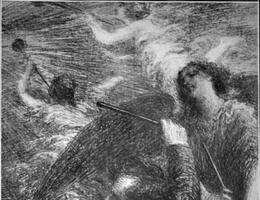Grande Messe des morts [Requiem] op. 5
1. Requiem et Kyrie – 2. Dies irae – 3. Quid sum miser – 4. Rex tremendae – 5. Quaerens me – 6. Lacrimosa – 7. Offertoire – 8. Hostias – 9. Sanctus – 10. Agnus Dei
Berlioz composed his Great Mass for the Dead, or Requiem, in response to a commission from the French Ministry of the Interior. It was first performed on 5 December 1837 in the church of Saint-Louis des Invalides as part of a ceremony commemorating the death of General Damrémont. The conductor was Habeneck. The work requires sixteen timpani in pairs, four gongs, and four brass groups, to be placed at the four corners of the vocal and instrumental groups. Berlioz told his friend Humbert Ferrand: “It is a success that popularises me, that was the main thing; it made an overwhelming impression on people with widely differing sensibilities and tastes.” The spectacular effects owe their relief to the diversity in the composer’s treatment of the massed forces. The “terrifying grandeur” of the Tuba mirum (taken from the Messe solennelle of 1824), with its four brass groups separated spatially, is contrasted with the introspection of the Quid sum miser and the neo-Renaissance a cappella polyphony of the Quaerens me. While several passages show the influence of Revolutionary music, others are astounding in their audacity. These include the four-octave abyss in the Hostias between the extreme registers of the flutes and the trombones; in the Offertorium, the melodic monotony of the chorus, set like a jewel in the orchestral accompaniment (an idea Berlioz took up again in the “Funeral cortège for Juliet” in Roméo et Juliette, 1839). Berlioz took a rather free hand with the text, discarding the Gradual, the Tract, and the Benedictus, and deleting certain verses or changing their position. Such appropriation shows the strength of his commitment. Indeed, for the rest of his life Berlioz retained an unwavering affection for his Requiem. “If I were threatened with the destruction of the whole of my works save one, I should crave mercy for the Messe des morts," he told Ferrand in 1867.


